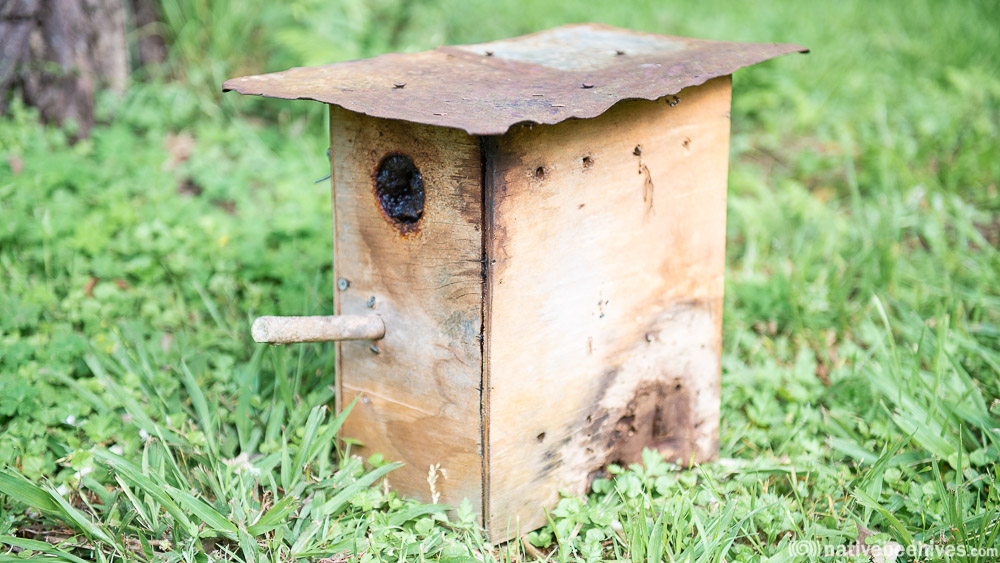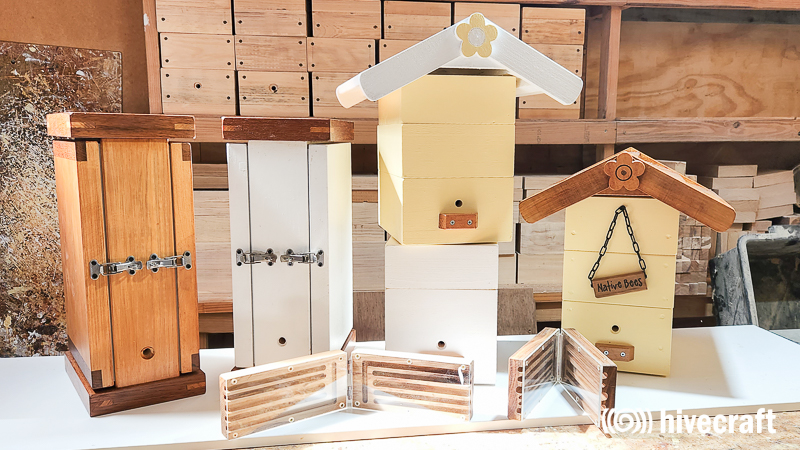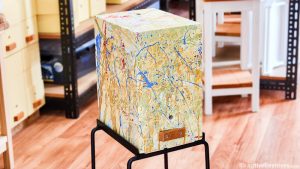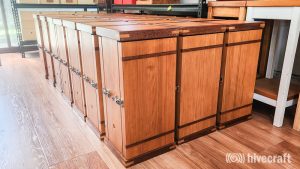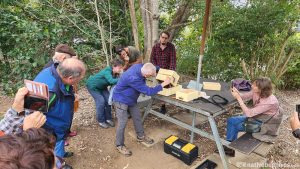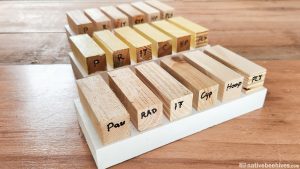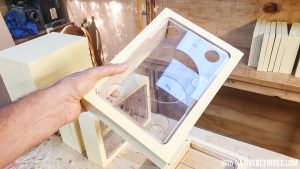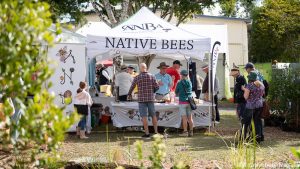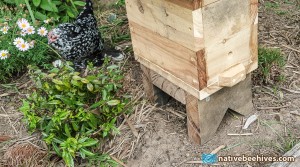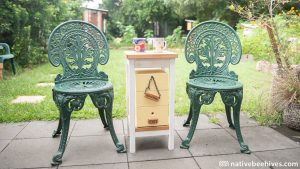Photo: Thin plywood bird house with a very strong stingless bee colony inside just south of Coffs Harbour
Is there an Industry Standard?
There’s currently no industry standard. The most common design made and used around Australia is the OATH box created in the 80s. It can be relatively cheap and easy to make. There are plenty of other designs around and most are just variations of the OATH, but so far none have proved to be any better in function or ease of use than the OATH design. I’m not sure how anyone could prove their design is any better either. In reality, the OATH is just a box, and the majority of boxes are similar.
Apart from looks and function, cost and ease of manufacture can be a major part of design and if it costs too much or is too complicated to make, the industry and general community wont take it up.
Shape – Rectangle / Square / Round
There isn’t any research on box shapes. Some will say “look to nature”, suggesting round is best. Tree hollows tend to be long and narrow and may have just been what bees had available. Stingless bees also build colonies in ground cavities which are odd shapes. In suburbs there may be no tree hollows available and bees will build nests in water meters which are rectangle. The volume of a water meter pit seems too large as the bees will section off areas with a propolis wall and the shape they section off could be a triangle in the corner. If we look to nature maybe boxes should be vertical, long and narrow volumes?
Internal Volume
This can be dependent on the species. T.carbonaria and T.hockingsi will be ok with 3 to 8 litres. They can get by in very small volume areas like 2 litres, but 6 to 8 litres might be optimum for colony size and strength. It’s best to start with a smaller volume and as the colony strength increases you can increase the volume by opening up more space or adding a new level. Giving the bees access to full volume of 8 litres straight away may cause the bees to section off an area. *Splitting a 6 to 8 litre box is perfectly ok as the bees will already be filling out a 3 litre section of the box and will expand in to the rest of the box.
Split box vs Non split
There’s pros and cons for each design. Non split boxes may be easier to produce and provide less joins or gaps for better home security against pets or outside elements but a possible downside is that you can’t easily multiply colonies using non split boxes. Multiplying colonies would have to be done using the budding/eduction methods and then a lot of times people will add brood that they had to open another colony to extract. The most common design is a box that is made of different sections that can be split to multiply the colonies. Splittable boxes are a very practical convenient and efficient system.
Frame height
Most bottom brood boxes or middle brood frames people make are from 70mm to 100mm high. It doesn’t seem too critical. A lot of people will make a frame 100mm high purely because that’s the size of the timber they bought. If you want to focus more on the beneficial height you could look at the size and position of the brood inside the box and aim for a height that when split, is more likely to split the brood in half, which might be 70mm. Sometimes with the 100mm frame height, the whole brood can stay within that frame when splitting. I have seen a frame height of 150mm that works ok.
Split bars vs split plates
Permanent split bars work very well and are quite common. Split plates have become popular in recent years and work very well also. Keeping the split plate as minimal as possible might be best with lots of access holes. Masking tape can also be used in place of split bars to support the upper structures after a split. The bees will chew it away before long. Split bars are only useful for a short time while the bees repair structures and for the rest of the year they’re not needed.
Internal structures, split bars and plates and airflow
Does adding internal structures reduce airflow or cause temperature or moisture issues? Airflow in a hive may be impossible to measure and compare between designs. For internal air flow the best design is to have no internal structures at all. The more you add the more it could interfere with the air flow. On a sliding scale, split bars cause minimal impact and it’s possible full split plates could be isolating sections and have a negative effect on airflow which may require vents being added.
Vents / humidity / condensation
Some designs have no vents though most box builders will add a vent in the rear. Some designs have a vent in the bottom and a vent on top. Some designs have a vent in the side on each frame level. Vents might be added to a box to try increase airflow or reduce a moisture or condensation issue. Randomly bees may leave these vents open or close them up with propolis.
Paint colour, clear coat and raw wood finish
White paint is best to reflect sun in summer though pale colours are perfectly fine and may only increase the internal box temperature by a couple of degrees. Darker colours could be an advantage in winter to warm the colony. Clear coats or raw wood finishes can increase the box temperature a few degrees and caution should be taken in full sun in summer with box position. Clear coats don’t contain UV blockers and will deteriorate in the sun faster.
Hoop pine vs Cypress construction and longevity
This is a common debate. Hoop pine is a very stable timber to work with and can give a good fitment in a finished box, while cypress is not usually kiln dried and can shrink and warp badly so needs a lot of time to dry before using. If a box is made from cypress that hasn’t had a chance to dry the frames can warp giving bad fitment issues and there’ll be large gaps between the frames. Cypress is perfectly ok to use, just make sure it’s aged or dried properly.
If kept out of high moisture areas hoop pine will last many years. Any moisture issues with hoop pine can be caused by outside water issues like being exposed to rain with inadequate rain protection. Cypress will last many years exposed to the weather.
Timber thickness, Softwood vs Hardwood and temperatures
The common 25mm hoop pine painted pale yellow will warm up faster and lose heat faster than thick hardwood, and in turn, thick hardwood is slow to gain and slow to lose heat. The hoop pine box painted pale yellow seems to top out at a lower temperature compared to the thick hardwood when exposed to full sun. The thick hardwood, while slow to gain heat, can get a hotter than the yellow hoop pine box in summer. Caution should be taken in summer in full sun.
In winter thick hardwood boxes are slow to gain heat and can be cooler. This might be helped by placing the box in full sun. If painted white the thick hardwood box takes longer to warm up and will not get as warm as the 25mm hoop pine box. Bees can struggle to warm up in winter with a thick hardwood box in the shade.
PVC vs Wood
This is often debated but it’s more about opinion or personal preferences. The bees don’t seem to mind and can naturally build their colony in all kinds of plastic things like bags, traffic cones and very commonly in water meter boxes, of course water meters have a dirt floor which may help with controlling the environment inside, but are five sides of plastic. The bees preference might be just to have a secure area. Some say PVC boxes cause condensation, though wood boxes have condensation issues as well and no research has been done to explore a comparison. Condensation is moisture in the warm air touching a cold surface, returning to liquid and might be more to do with the thickness of the PVC, temperatures outside and inside the box and ventilation.
Drain holes
Some boxes have drain holes and a lot don’t. Drain holes can be useful but aren’t critical. These can be handy if transferring a colony in to a box where there is spilt honey. If the box has drain holes make sure the box also has feet that keep the box above the surface so the drain hole isn’t blocked.
Honey super
The honey super isn’t a necessary part of a stingless bee box. The bees will naturally store their honey in the main box usually around the rear area behind the brood. Honey super volumes could be anything from 1/2 litre slim boxes to 2 litres. The honey super can provide a good storage space for the bees for the hard times, or if you’re interested in harvesting honey the honey super provides an easier way to access it without disturbing the main colony.
Honey Super Divider Plate / Brood Excluder
This plate separates the honey super section from the rest of the main colony structure. It blocks the bees from building the brood any higher, leaving an open area for the bees to store honey in.
Viewing Window
These are usually made from thin perspex or the clear A4 binder covers. It can be handy to be able to see in to the colony but isn’t important to have in a native bee box. Viewing windows have only recently become popular in the last couple of years so many boxes don’t have them and they may only suit a certain design with an open top. Not having a viewing window shouldn’t be a deal breaker when buying a hive.
Front step landing pad
The front step isn’t a necessary part of the stingless bee box. Usually cosmetic though can be useful for bees to land on and can also serve as an identifying marker to aim at.
Box Feet
Adding some kind of wood spacer or screws under the box help keep it off the surface below. This can help with ventilation and keep moisture away from the timber.
Box add ons / accessories
Foam covers
Styrofoam covers can be added in an effort to provide insulation. In winter, adding a foam cover overnight could reduce the loss of heat but should be removed in the morning to allow the box to warm up. Leaving the foam cover on during the day in winter will keep the box cool, not allowing it to warm up.
Roof
Add a nice big roof. This keeps the rain off the sides and shields it from the sun. Rain can run down the sides of a box and enter gaps, flooding the box or causing mould or rot.
